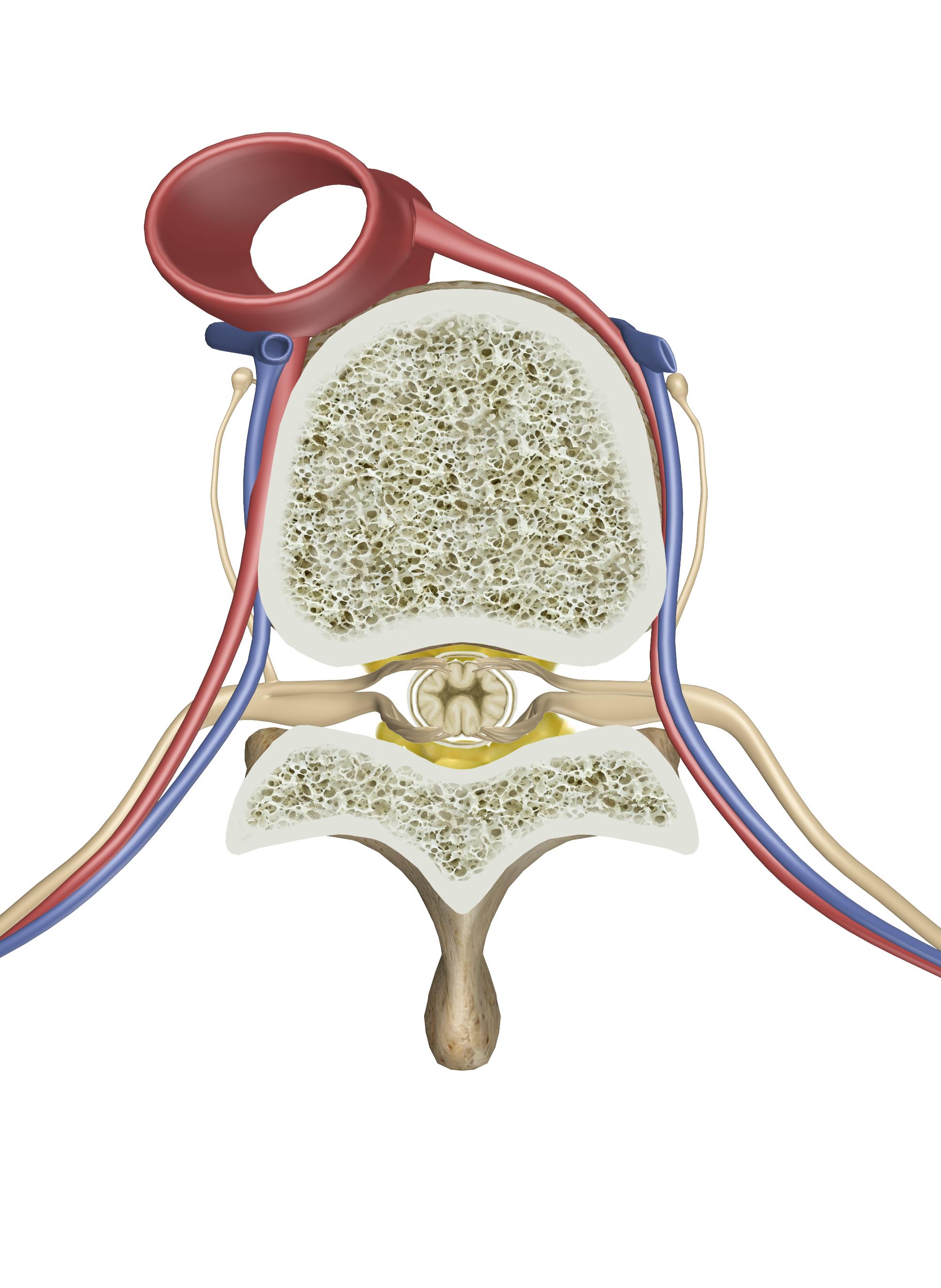The vertebrae and the spinal cord are vital structures of the skeletal and nervous systems in the neck and torso of the human body. Almost all nerve signals traveling to and from the body below the head pass through the spinal cord, making it the information superhighway of the body. The vertebra forms a bony protective conduit for the spinal cord while also providing strength and support to the soft tissues of the head, neck, and trunk.
Anatomy
The vertebral column, or spine, is a group of twenty-six stacked vertebrae extending from the skull to the pelvis. Most vertebrae have an irregular shape, with a large drum-shaped vertebral body on the anterior end and a thin ring-like vertebral arch on the posterior end. The vertebral body, also known as the centrum, makes up the bulk of the vertebral mass and supports the body’s weight. Between each pair of vertebral bodies is an intervertebral disc made of tough fibrocartilage. Extending from the posterior of the vertebral body is the vertebral arch, which surrounds the spinal cord. The spinal cord runs through the vertebral foramen, a hollow tube running the length of the spinal column. A pair of transverse processes extend laterally from the vertebral arch while a spinous process protrudes posteriorly from the posterior of the arch. Each of these processes acts as a muscle attachment point to move the spine.
The spinal cord is a thick cable of nervous tissue extending from the medulla oblongata of the brain stem to the neck and torso. Viewed in a cross-section, it has a roughly oblong shape with white matter on its exterior and a butterfly-shaped region of gray matter on its interior. A small, circular tube-like cavity known as the central canal sits in the center of the gray matter. The central canal is filled with cerebrospinal fluid, which circulates from the ventricles of the brain to the central canal and around the surface of the spinal cord.
White matter looks white because of the myelin sheath covering its axons. While the spinal cord’s white matter appears undifferentiated to the naked eye, it contains many smaller structures within its tissues. Several shallow furrows (known as sulci) and a deep furrow (known as the anterior median fissure) penetrate the white matter and divide it into several regions. Each of these regions, or columns, contains thousands of axons traveling between the brain and the body’s tissues. The columns are further divided as axons traveling to the brain form clusters known as ascending tracts while axons leaving the brain form descending tracts.
The butterfly-shaped gray matter extends from the central canal anteriorly to form the anterior gray horn, laterally to form the lateral gray horn, and posteriorly to form the posterior gray horn. Sensory neurons enter the spinal cord through the posterior spinal root, and their axons make up the posterior horn. Motor neurons exit the spinal cord through the anterior roots of the spinal nerves, so they are found in the anterior and lateral horns. The cell bodies of autonomic motor neurons are found in the lateral horns and extend their axons through the anterior horns, while the cell bodies and axons of somatic motor neurons are only found in the anterior horns. Interneurons that connect the sensory and motor neurons are found in the center of the gray matter between the horns.
Meninges and soft tissues surround the spinal cord, protecting its delicate nervous tissue and containing cerebrospinal fluid. The innermost layer of meninges, the pia mater, covers the surface of the spinal cord and contains many blood vessels to support the spinal cord’s tissues. Cerebrospinal fluid flows around the pia mater in the hollow subarachnoid space beneath the second layer of meninges, the arachnoid mater. The outermost layer of meninges, the dura mater, forms the tough outer shell of dense fibrous connective tissue that protects the spinal cord. A layer of epidural adipose tissue fills the space between the dura mater and the vertebra and acts as a shock absorber for the spinal cord.
Physiology
The vertebra provides several crucial functions to the body. First, it acts as a structural component of the spine, bearing body weight, anchoring muscles and the spinal cord, and forming joints with other vertebrae and ribs that allow the torso and neck to move. Second, the vertebra protects the delicate tissues of the spinal cord by surrounding it with hard bone tissue. The spinal cord acts as a conduit for information between the brain and the body below the neck. Descending nerve signals from the brain pass through the white matter to activate the muscles, glands, and organs of the body, while ascending nerve signals carry sensory information from the tissues of the body to the brain.
Another function of the spinal cord is maintaining muscle tone and producing reflexes. The integration of sensory information produces spinal reflexes in the spinal cord to cause a motor response to stimuli faster than the distant brain could make the same response. An example of a spinal reflex is withdrawing the hand when it detects pain. The spinal cord creates this response before the brain becomes aware of the stimulus to prevent further damage to the affected tissues.

